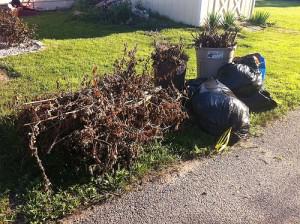 Most U.S. cities offer some type of curbside yard waste pickup. Every season, the streets and roads are lined with huge paper and plastic bags, all filled with dried leaves, grass clippings, and branches. The ecological results of this are numerous.
Most U.S. cities offer some type of curbside yard waste pickup. Every season, the streets and roads are lined with huge paper and plastic bags, all filled with dried leaves, grass clippings, and branches. The ecological results of this are numerous.
The bags containing the waste end up in our landfills. The waste trucks are using excess fuel for the trips through the neighborhoods on designated yard waste days. Burning large quantities of your yard waste will affect systems for pollution control. In the meantime, this “waste” could easily be used to cultivate soil, protect new plants, and brighten a flower bed near your garage door.
What Is Composting?
Composting turns that pile of organic waste you created into something useful. Materials like grass cuttings, shredded leaves, fruit and vegetable clippings, coffee grounds, and newspapers combine with water and air to begin biological decomposition. The resulting compost can then be used as soil amendment or for growing plants.
Here’s How to Do It . . .
- Shred: The decomposition of any compost pile depends on shredded or very small matter. If leaves are not broken down, they will clump together, which prevents them from proper temperature control and aeration.
If you don’t happen to have a shredder (few do), then don’t fret. You can get the same effect by piling your leaves and running through them with your lawnmower. - Layer: A compost pile needs to be formed using a correct balance between nitrogen and carbon. Two parts brown to one part green is recommended. Dead leaves have a lot of carbon content, so adding a nitrogen-rich material like grass clippings, vegetable scraps, or manure is crucial. Layer until you have no materials left.
- Turn: Your compost needs proper aeration. Make sure you are frequently turning it using a pitchfork or other appropriate yard tool. Maintaining the proper air flow has a dual benefit. First off, it helps to prevent noxious odors. Secondly, it allows the pile to heat evenly by constantly resetting the temperature.
- Water: The most important ingredient with composting is moisture. It is even more important if you are including fibrous browns, like dried leaves. Too much water leads to mold, while not enough will hinder the process of decomposition.
The proper dampness level is equal to a towel that has been wrung out. Depending on where you live, you can choose to manually add water or depend on the natural influx of moisture. Consider a lid on your compost bin to help keep in the moisture.
Join in the discussion in the comments below and/or share the piece.
Photo credit: 



